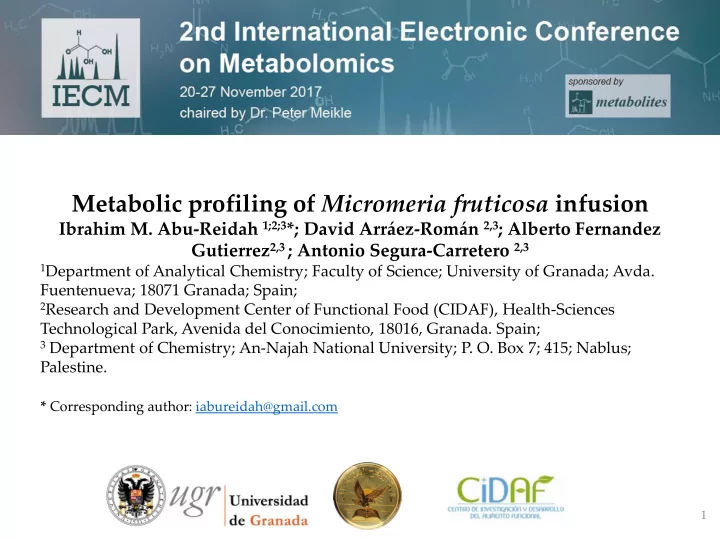

Metabolic profiling of Micromeria fruticosa infusion Ibrahim M. Abu-Reidah 1;2;3 *; David Arráez-Román 2,3 ; Alberto Fernandez Gutierrez 2,3 ; Antonio Segura-Carretero 2,3 1 Department of Analytical Chemistry; Faculty of Science; University of Granada; Avda. Fuentenueva; 18071 Granada; Spain; 2 Research and Development Center of Functional Food (CIDAF), Health-Sciences Technological Park, Avenida del Conocimiento, 18016, Granada. Spain; 3 Department of Chemistry; An-Najah National University; P. O. Box 7; 415; Nablus; Palestine. * Corresponding author: iabureidah@gmail.com 1
Metabolic profiling of Micromeria fruticosa infusion Graphical Abstract M. fruticosa M. Fruticosa Infusion M. fruticosa fresh leaves water infusion filtration dried leaves 2
Abstract: Micromeria fruticosa (Lamiaceae); also known as White micromeria; is a widely distributed herb; native to Palestine and the Mediterranean region. The infusion of M. fruticosa areal parts is used to relieve stomachaches and heart disorders and hypertension. M. fruticosa has also been reported to have different biological activities viz. antioxidant; antimicrobial; anti-inflammatory; and gastroprotective properties. Even though there have been many attempts to study the chemical composition (essential oils); the study of other phytochemicals is still limited. Although the plant is broadly used in the folk medicine; no thorough identification is available on the metabolites of M. fruticosa traditionally-made infusion. To this end; the aim of the present work has been to investigate the metabolites in the infusion of M. fruticosa . The analysis of the phytoconstituents of the infusion was carried out on LC equipped with an C 18 column. acetonitrile and Acidified water were used as mobile phases. By the method used more than 150 metabolites (derivatives of phenolics; flavonoids; among others) were identified in M. fruticosa ; highlighting the importance of this plant as an important source of bioactive phytochemicals. Keywords: Lamiaceae; Micromeria fruticosa ; metabolites; phenolics; LC- MS/MS 3
Introduction White micromeria (Lamiaceae), is an aromatic herb widely distributed in the wilds of the Mediterranean countries. M. fruticosa typically grows in clefts of fissured rocks in the open habitats. Herbal parts of the plant are frequently being used as seasonings in soups and foods. M. fruticosa is endemic in Palestine, and is known as �Zie’tt�a��, �Zaa’tar balat �, and � Ishbat Al- Shay� . Aqueous extract was reported to be safe up to 5 g per kg. Extracts, teas and infusions of M. fruticosa are widely used in the traditional folk medicine to treat a variety of diseases, including gastrointestinal ailments (stomach ache and diarrhea), also to treat respiratory system (cough and colds), heart disorders,, headaches, urinary diseases, exhaustion, asthma, inflammation, diabetes and hypertension. 4
Introduction It is thought that the phytochemical composition of plants are partly responsible for such properties. Phenolics are considered one of the most widely distributed groups of substances in the plant kingdom with thousands of structures identified. In the bibliography, it is worth noting that very few works described the M. fruticosa chemical composition. Thus, the objective of this work was to provide an extensive screening of the M. fruticosa infusion for their phytochemicals by using LC-MS/MS in the negative ionization mode as a powerful analytical technique. 5
Results and Discussion • In the present work, a qualitative screening of the phytochemicals from the M. fruticosa infusion was established by using LC – MS/MS. A total of 68 compounds were tentatively identified via LC – MS/MS system along with their retention times ( t R ), molecular formula, detected accurate mass, error (ppm) of each compound, mSigma value, and the MS/MS fragment ions, all of which were used in the course of the characterization process. • By using the later technique, it was possible to characterize, more than 60 compounds in the negative ion mode. At the beginning of the chromatogram, the elution of several compounds belonging to organic acids and saccharide derivatives can be noted at the beginning of the analysis. • The LC-MS/MS method used has revealed the presence of 25 phenolic acid derivatives identified in the Micromeria fruticosa using accurate mass measurements in addition to the MS 2 fragmentation pattern. A total of 30 flavonoid conjugates have been characterized in M. fruticosa by using LC-MS method used. 6
Results and Discussion Intens. 1000 800 600 400 200 0 5 10 15 20 25 30 35 40 45 Time [min] Fig. 1 BPC of M. fruticosa obtained by LC-MS/MS 7
Results and Discussion p -Coumaroylagmatine Irigenin 7-glucoside Quercetin 3-O-[6''-O-(3-hydroxy-3- methylglutaroyl)- β -D-galactoside] Tricin 7-O-(6''-O-malonyl)-D-glucopyranoside Quercetin 3-O-(6''-malonylglucoside) Fig. 1 Structure of some identified compounds in M. fruticosa infusion 8
Conclusions • More than 150 metabolites, namely, flavonoids, phenolic acids, terpenoids, fatty derivatives are reported here in Micromeria leaves for the first time. • The obtained results may develop the knowledge on M. fruticosa through encouraging the research and the further use of this important medicinal food. • The results also highlight the importance of M. fruticosa as a promising source of functional ingredients, and boost its potential use in the food and nutraceutical industries. M. fruticosa leaves might be a potential source of natural antioxidants. 9
Acknowledgments 10
Recommend
More recommend